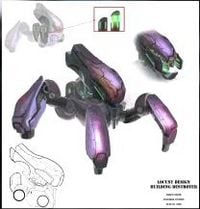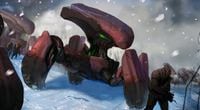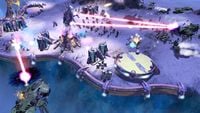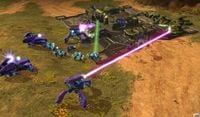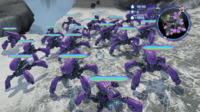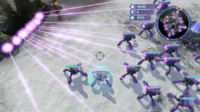Shua'ee-pattern Locust: Difference between revisions
From Halopedia, the Halo wiki
m (→Sources: clean up, replaced: {{Covenant Vehicles}} → {{Covenant Ground Vehicles}}) |
m (→Design details) |
||
| Line 38: | Line 38: | ||
==Design details== | ==Design details== | ||
[[File:Walkers.JPG|thumb|left|150px|Locusts and Scarabs fighting together.]] | [[File:Walkers.JPG|thumb|left|150px|Locusts and Scarabs fighting together.]] | ||
The Locust is a smaller, tank-sized counterpart to the [[Scarab]], which is also a repurposed mining platform. It does not share the Scarab's spiked 'feet', though it is capable of using its legs to climb over obstacles in a similar manner to its larger cousin.<ref>'''Halo Wars''', campaign level ''[[Dome of Light]]''</ref> Like [[Type-47B Scarab]]s | The Locust is a smaller, tank-sized counterpart to the [[Scarab]], which is also a repurposed mining platform. It does not share the Scarab's spiked 'feet', though it is capable of using its legs to climb over obstacles in a similar manner to its larger cousin.<ref>'''Halo Wars''', campaign level ''[[Dome of Light]]''</ref> Like [[Type-47B Scarab]]s the Locust can be piloted by a [[Sangheili]] or [[Jiralhanae]].<ref name="HW">'''Halo Wars''', Locust dialogue</ref> The Locust possesses one rotating turret, which is very similar in appearance to a [[Type-26 Banshee]]'s cockpit. The turret houses a single plasma cannon that fires a linear pink beam; this beam is effective against both ground and air targets and can outrange most equivalent weapons. The Locust has a regenerating shield that is capable of protecting the vehicle from a limited amount of weapons fire. | ||
==Operational history== | ==Operational history== | ||
Revision as of 07:36, June 21, 2018
| Type-30 Locust | |
|---|---|
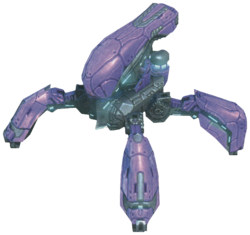
| |
| Production information | |
|
Manufacturer: |
|
|
Product line: |
|
|
Model: |
|
| Technical specifications | |
|
Length: |
5.8 meters (19 ft)[1] |
|
Width: |
12 meters (39 ft)[1] |
|
Engine(s): |
Quadrupedal leg assembly |
|
Other system(s): |
Energy shields |
|
Armament: |
|
|
Crew: |
1 operator |
| Usage | |
|
In service: |
|
|
Role(s): |
|
|
Affiliation: |
|
- "Destroy those Locusts wherever you find them. They're building killers!"
- — Sergeant John Forge[4]
The Type-30 Light Excavation/Anti-Fortification Platform,[1] more commonly known as the Locust, is a quadrupedal Covenant vehicle used for mining and combat purposes.
Design details
The Locust is a smaller, tank-sized counterpart to the Scarab, which is also a repurposed mining platform. It does not share the Scarab's spiked 'feet', though it is capable of using its legs to climb over obstacles in a similar manner to its larger cousin.[5] Like Type-47B Scarabs the Locust can be piloted by a Sangheili or Jiralhanae.[6] The Locust possesses one rotating turret, which is very similar in appearance to a Type-26 Banshee's cockpit. The turret houses a single plasma cannon that fires a linear pink beam; this beam is effective against both ground and air targets and can outrange most equivalent weapons. The Locust has a regenerating shield that is capable of protecting the vehicle from a limited amount of weapons fire.
Operational history
Human-Covenant War
In February 2531 Locusts were used by Covenant forces on Arcadia and Etran Harborage in long-range artillery roles against UNSC forces.[6]
Post War
In the post-war era, remnants of the former Covenant empire still used the Locust, though their roles have somewhat changed: while some are employed by fierce Jiralhanae raiding parties looking to pillage colony worlds, Sangheili kaidons and warlords used them to fortify keeps and protect fragile alliances.[7] In September 2558, a Jiralhanae chieftain named Hekabe had access to Locusts during his attack on Carrow.[8]
Gameplay
Halo Wars
The Locust has the longest effective range among the Covenant ground units in Halo Wars and costs 300 resources, a tech level of 2, and a population space of 2. The Locust is specifically designed to take down static targets, and is only able to open fire when stationary. The Locust can be upgraded with the 'Overdrive' ability as well as with the 'Shield Amplifier' ability. The former upgrade allows the Locust to divert energy from its shield generator to its main cannon, increasing its attack power; the latter upgrade allows the unit's shield to regenerate faster.
Known as a 'building killer', the Locust is largely used to attack an enemy's defenses from a safe distance. This is a useful alternative to a direct confrontation, which would result in casualties for the attacker. A small group of Locusts can be used to assist a force of smaller warriors, like Kig-yar, making it far easier for the group to destroy enemy buildings. Larger groups of Locusts can be used in surprise attacks against enemy bases and in such cases, the Locusts can often level the targeted base in thirty seconds. However, the inherent vulnerability of the unit makes this a gamble. The Locust is fairly weak against non-structure targets. Though it is able to do significant damage to units, the Locust's defences are weak and falls quickly to concentrated fire. However, its beam can lure enemy units towards awaiting forces, allowing them to be quickly cut down. Although less common, the Locust can be used quite effectively to destroy small groups of air units such as a formation of vultures. This is provided the player has a sufficient number of Locusts and that they attack from long range to reduce the amount of casualties that will inevitably be taken.
The following upgrades are available:
- Overdrive is a special attack that drains the Locust's shields to boost damage. Requires 400 resources and a tech level of 2.
- Shield Amplifier increases the Locust's shield-regeneration rate. It is useful when used with Overdrive, and its effects also stacks with the 'Shield of the Forerunners' upgrade from the Temple, allowing for an even quicker regeneration rate. Requires 800 resources and a tech level of 3.
Trivia

|
Browse more images in this article's gallery page. |
When playing as the UNSC in multiplayer or skirmish modes, Serina may say, "Watch the skies — they've got Locusts." This, along with the Locust being first encountered in-game in a mission where other attacking enemy units are airborne, and the real locust being able to fly, may mean that the Locust was an air unit at some point in the development of Halo Wars.
Gallery
Concept art of a Locust accompanied by Jiralhanae warriors for Halo Wars.
- LocustWeb.jpg
Concept explorations of the Locust.
Locusts engaging UNSC forces.
- Locust.jpg
A Locust on Harvest.
List of appearances
- Halo Wars (First appearance)
- Halo: Envoy
Sources
- ^ a b c d Halo: The Essential Visual Guide, page 110
- ^ Halo Waypoint: Universe, Vehicles, Scarab
- ^ Halo Encyclopedia, page 245
- ^ Halo Wars, campaign level Scarab
- ^ Halo Wars, campaign level Dome of Light
- ^ a b Halo Wars, Locust dialogue
- ^ Halo Waypoint: Canon Fodder 4/1/2016: Issue 69 No Joke
- ^ Halo: Envoy, Chapter 5, page 60
| ||||||||||||||||||||||||||||||||
